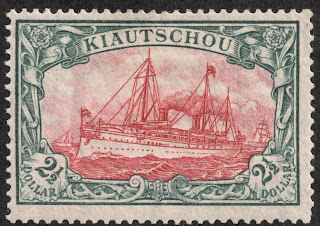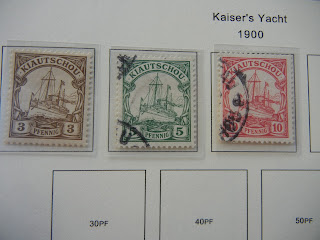1905-16 Scott 42 $2 1/2 slate & carmine
Kaiser's Yacht "Hohenzollern"
Quick HistoryKiauchau (or Kiautschou) was a German colony between 1898-1914 located in China on Jiaozhou Bay along the Shandong Peninsula and the Yellow Sea.
Shandong Peninsula
After the murder of two German missionary priests, the Germans seized the Chinese munitions depot located on Jiaozhou Bay in 1897. Then, through subsequent negotiations, they obtained a 99 year lease from the Chinese government.
"The Kiautschou Bay concession"
The area consisted of 213 square miles (552 square kilometers) around Jiaozhou Bay.
Imperial German Navy occupying the munitions depot, 1898
Tsingtao (Tsingtau, Qingdao) was founded, and the Germans developed streets, buildings, electrification, a sewer system, and a water supply. Tsingtao was always under the command of the Imperial Navy, and not the Imperial Colonial Office, because of its strategic location.
City map of Tsingtao, 1912
In 1914, the population was approximately 190,000. Today, Qingdao is a metropolis of 8 million.
Tsingtao Pilsner
A brewery was also founded in 1903.The Tsingtao pilsner is the most popular exported beer from China.
The Siege of Tsingtao, Japanese Lithograph
With the WW I outbreak, Japan joined the Allies, and they, and a much smaller contingent of British, lay siege to Tsingtao. Capitulation and occupation occurred on November 16, 1914.
After WW I, the territory was awarded to...Japan. !!!
Naturally, this did not sit well with the Chinese. This sparked the "May Fourth Movement", with a significant surge in Chinese nationalism
Eventually, the lands were given back to China in 1922.
1901 Scott 11 5pf green
Into the Deep Blue.
The 2011 Scott Classic Specialized catalogue has, from 1900-1916, 42 major descriptions for the stamps of Kiauchau. Of those, 12 are CV $1+-$3+ ( 29%).
In addition, there are 12 Scott listings (A1-A12) with the German Offices in China stamp overprint and cancellations from Kiauchau, beginning in 1898. CV for the least expensive is $9+.
100 Pfenning = 1 Mark
100 Cents = 1 Dollar (1905)
The surcharged "5 Pfg, 5 Pf" Tsingtao issued nine stamps of 1900 are quite expensive ( CV $50+-$30,000 +), have been counterfeited, and are out of the league of almost all general classical era collectors. I will say no more about them. ;-)
A closer look at the stamps and issues
As expected, The familiar "Hohenzollern" design is used here for the colonies issues.
1901 Scott 10 3pf brown
The unwatermarked 1901 issue consisted of 13 stamps, with denominations from 3 Pfennig to 5 Mark The lower denominations are typographed, while the higher ones are engraved. CV is $1+ - $15+ for 8 stamps.
1909 Scott 35 4c carmine
Watermarked 135, Lozenges
The 1905 issue was in cents/dollars, but otherwise was similar in design to the 1901 issue. There are 10 stamps in the set, and they are unwatermarked. CV is $1+-$5+ for 4 stamps.
The next issue, from 1905-16, is the same as the 1905 issue, except it is watermarked. CV is $1+- $10+ for 8 stamps.
The illustration above is from the later watermarked issue.
Note the nice "Hafen" (Harbour) Kiautschou postmark with date May 9, 1911.
Lozenges watermark (wmk 125)
The Lozenges watermark is usually apparent without much difficulty.
1908 Scott 37 20c lake & black, wmk Lozenges
The 20c and 40c of this issue are typographed, and bicolored. Great image.
1905-16 Scott 42 $2 1/2 slate & carmine, wmk Lozenges
Kaiser's Yacht "Hohenzollern"
The higher values are engraved, as illustrated. A really great looking image. :-)
Deep Blue
The Pfennig/Mark issue in Deep Blue
The Steiner pages (Deep Blue) are two in number, and have all the major Scott numbers with a space. If one is picky about separating the unwatermarked/watermarked series, then the spaces are much appreciated. ;-)
1901 Scott 12 10pf carmine
Note postmark, which is a "1898" Type B in Scott
Big Blue
Big Blue '69 has Kiauchau on one line of one page (along with Karelia, Kionga, Marienwerder), after the Kenya, Uganda, Tanganyika entry. No doubt the '97 has Kiauchau on its own page. Kiauchau is found for the '41/'43/'47 editions just after Japan.
All of the editions have eight spaces: 3 for the 1900 issue, and 5 for either the 1905 or 1905-16 issue.
Coverage is 19%.
For the "1905-10 " spaces: Either the unwatermarked (Scott 23-27) or the watermarked (Scott 33-37) stamps may be placed in the spaces. But the CV can be much higher for the unwatermarked issue, so checking for watermarks is a good idea. ;-)
No stamp spaces require a CV $10 or higher stamp.
Checklist
1900
10,11,12,
1905-10*
23 or 33, 24 or 34, 25 or 35, 26 or 36, 27 or 37,
End
Comments
A) Expensive stamps ($10 threshold): None
B) *1905-10 - either the unwatermarked (Scott 23-27) or the watermarked (Scott 33-37) stamps may be placed in the spaces.
1909 Scott 34 2c green
Out of the Blue
If one wants to have a rewarding adventure, spend more time exploring the history of Kiauchau. Fascinating.
Note: Maps, pic appear to be in the public domain.

















In 2010-2011, I lived and worked as an English teacher in Qingdao. During my sojourn there, I did visit the German Governor's Mansion. At that point, it dawned on me that Qingdao was formerly part of this the obscure German Colony.
ReplyDeleteGre Gina!at story
DeleteQingdao (Tsingdao) is also the beer found in China - naturally the Germans developed it.;-)
Yes, I sampled a bit of that beer there too. :)
Delete